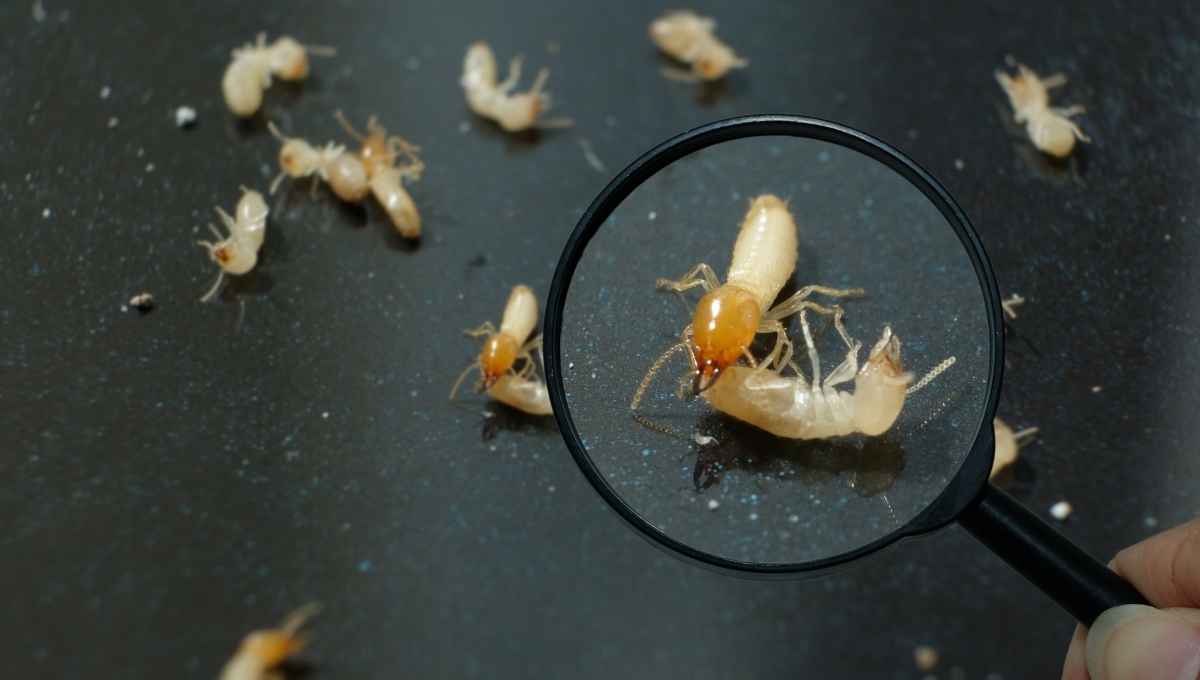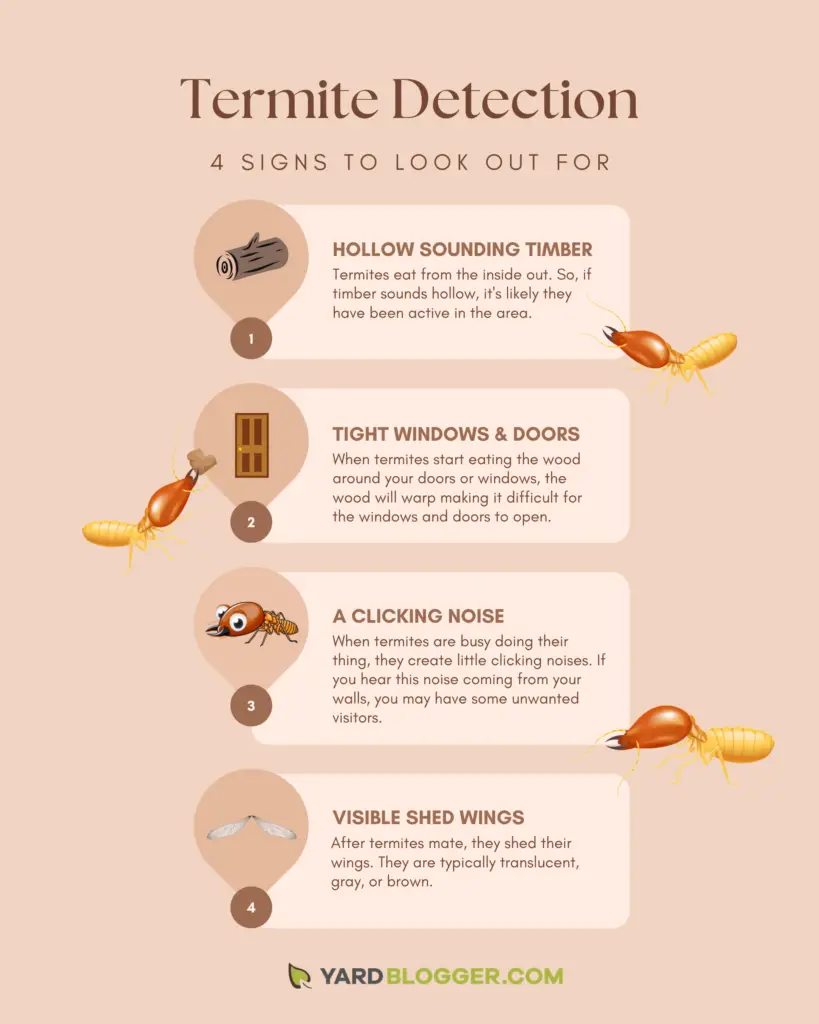My Neighbor Has Termites! (How to Stop Them From Spreading)

Shockingly, 600,000 houses in America deal with termites every year. These little bugs can cause a lot of damage to a single house, so it can be quite nerve-wracking to hear that your neighbor has a termite infestation. Can their termite infestation become yours?
If your neighbor discovers a termite infestation, you likely have an infestation as well. And, the closer you live to your neighbor, the higher the chances are. You should hire a professional immediately to assess your house for any termites.
Signs like small holes in your dry wood walls or tunnels in your foundation could signify a termite infestation.
In this article, we’ll go through some signs you should be wary of and what to do if your neighbor discovers termites in their house.
This post contains affiliate links from Amazon and other stores. This means Yard Blogger may earn a commission if you make a purchase using any of our links. Please refer to our full affiliate disclosure policy for full details.
Here’s a Quick Pro Tip!
Even though the word termite might make your hair stand up, there are ways to prevent these bugs from creeping into your walls.
Here are some products that we highly recommend to keep termites away.
1. Termite detection stakes – Plant around your foundation to detect any signs of termites in the soil.
2. Airtight containers – Ideal for storing clothes or cotton sheets for long-term storage.
3. Concrete patch filler – Necessary to prevent termites from accessing your house through the foundation.
Termites in The Neighborhood
So if your neighbor or a house in your neighborhood has been infested with termites, the chances are your house might be next on the agenda.
However, if you take the proper precautions, you could avoid termites altogether.
Should I Be Worried if My Neighbors Have Termites?
If your neighbor discovers termites on their property, you should worry about your property. Your house is at risk of also having a termite infestation. The closer your neighbor’s house is to yours, the greater the risk.
Termites like to find an environment that is similar to their current environment. Since your house is close to your neighbors’ house, termites will probably target your house next.
They also don’t like to travel far, making your house the best option.
Can You Spread Termites From One House to Another?
Termites can spread from one house to another. For example, some termites spread through wood, so moving an infested plank from one property to another could cause an infestation. At the same time, other termites travel through the soil and even though portable items like clothing.
You can try to prevent the termites from targeting your house by sealing up any cracks in the foundation. Termites can’t move through solid concrete.
So this makes it more difficult for them to reach your house.
Do Termites Spread From House to House?
Even though termites can spread from one house to another, it’s not very likely. The chances are that if your neighbor has termites, you already also have termites. However, there are ways to minimize the infestation.
The most important step is to contact a termite pest control specialist to evaluate your home and check for an infestation.
In the meantime, you should limit the amount of wood on your property or keep it off the ground level.

What to Do if a Townhouse Neighbor Has Termites?
After contacting a pest control professional, remove any dead wood pieces from your property. Check all wooden furniture or structures on your property for damage or signs of an infestation.
Termites love wood, but subterranean termites also love water. So if you have any water leaks on your property, it could attract these specific termites.
You should also make sure your foundation has no cracks or damage for termites to slip through.
How Do Termites Spread From One House to Another?
There are a few popular termite species, and each travels in a different mode. For example, some travel in dry wood, so if you unknowingly bring a piece of infested wood onto your property, it could spark an infestation.
Other termites live in the soil and prefer warm and wet, muddy environments.
They can travel from the soil of your neighbor’s yard to yours and infiltrate your house through wood sources (like a tree).
Do Termites Relocate?
Termites do relocate, but not just because they like a road trip. Termites will relocate if the new habitat has all the specifications they enjoy. For example, if your house has a lot of dry wood or poor maintenance, it’s more likely that termites will relocate.
So to prevent termites from targeting your house, you should keep up with leaky water pipes, AC units, or faucets.
Don’t leave firewood lying on the ground and if you see signs of an infestation, call a professional to help as soon as possible.
You might also enjoy our post on How to Deal With Termites in Firewood
What to Look For
If your neighbor discovers termites, what signs do you need to look out for? What does a termite even look like?
Well, in this section, we’ll answer all these questions and discuss what you should keep an eye on.
What Does a Termite Look Like?
Over 40 species of termites are found in the United States, and all come in their own shapes and sizes. Generally, a termite is between ¼ and ½ of an inch long and has a soft body and straight antennae.
Their colors can range from white to light brown, varying between worker and swarming termites. Colonies also have a Queen, a larger termite (usually over one inch long).
The Queen is responsible for laying eggs for the colony.
How Can You Tell How Long You’ve Had Termites?
A termite infestation is not something that can be seen immediately. Sometimes it can take years before you start noticing any damage; by that time, you probably already have a lot of underlying damage.
According to the NC State Extension Website, a colony of 60,000 worker termites could consume one foot 2×4 in five months.
That should estimate how long you’ve had termites, although a professional could give you a more accurate estimate.
Generally, when you see a termite swarm, your house has had a termite infestation for three to five years. Unfortunately, during this time, the colony will have grown into massive amounts of termites.
How Do You Tell if You Have Termites Inside Your Walls?
Small pinholes, faint lines, or bubbles in the paint could all be possible signs of a termite infestation inside the walls of your home. It’s most likely subterranean termites, so check for inexplicable soil on your walls.
If you notice any of these signs, you should contact a pest control professional to examine your home and determine if you have a termite problem.
Drywood termites eat wood from the inside out, so if you tap on your wall and it sounds hollow, you could have dry wood termites.
What Does Termite Poop Look Like?
Drywood termite droppings are small rounded pellets, usually about 1/25 inch long. Depending on the food source, the droppings might look like coffee or salt. If the termites are eating lighter wood, the droppings will be a lighter color.
Subterranean termites do not leave droppings as evidence of their infestation. Instead, you’ll likely see small mud tunnels run up your wall as a sign of these termites.
In addition, you might see mounds of dry wood termite droppings when you lift your floorboards.
How Long Do Termites Live in Wood?
Worker termites have a lifespan of up to two years, but the Queen of the colony could live up to a decade. This implies that termites could live in the wood of your house for up to a decade, maybe longer if not treated.
In most cases, you won’t immediately see signs of a new termite infestation.
This is because swarming termites leave an established colony to procreate and create a new colony; it takes a few weeks for the eggs they lay to become working termites.
What Are Some of the Outward Signs of Termite Damage?
There are a few signs that could indicate a termite infestation. Wood that sounds hollow when you tap it and small pinpoint holes in your drywall are two of the most common signs of termite damage.
Other signs that could indicate termite damage include:
- Peeling paint (looks similar to water damage)
- Crumbling wood
- Extremely squeaky floorboards
- Tiles loosening
- Mounds of termite droppings
- Mounds of wings (usually left behind by swarming termites)
- Small mud tunnels leading into your foundation
What Does a Termite Swarm Look Like?
A termite swarm consists of up to 100 winged termites taking flight and moving to a nearby preferred location. Termites only swarm when their current colony has reached capacity.
Thus when you see a termite swarm, you should immediately check your house for signs of infestation or call a pest control professional.
Unfortunately, for many people, a swarm is the first sign they see of an infestation, even though the termites have been in their houses for years.
Stopping the Spread
So you know what termites look like, and you know that they spread quite easily. So let’s look at prevention – specifically, how to prevent those little bugs from building an unwanted colony in your walls.
How Do You Prevent Termites?
You should ensure the foundation and soil around your house are properly graded and drained to keep it as dry as possible. You should also reduce the possible entry points for termites, so fill up cracks in your foundation.
Termites are very common in the United States since many houses are made of wood, but there are certain measures that you can take to prevent termites from targeting your house.
You should also fix any water leaks on your property as soon as possible.
Can Termites Be Carried on Clothing?
Termites like cotton, so technically, they can be carried and spread through clothes. Although, the chances are extremely low. Since we wash our clothes and move them around often, termites usually can’t base a colony on clothes.
That being said, if you prefer to store your out-of-season clothes in your attic, you should store them in an airtight container.
This prevents termites from attaching to your clothes and using them to spread to the rest of your house.
How Quickly Do Termites Spread?
Even though they might take years to show damage, they spread in a very short period of time. Within a few days, swarming termites could transform into a colony. So if you notice any signs of an infestation, you should act quickly.
You could plant termite detection stakes around your house. These stakes will indicate when termites are detected, giving you a fair warning to call a professional.
It takes minutes to install and could save you a lot of money in wood damage.
What Attracts Termites to a House?
All termites are attracted to wood, but as their names suggest, species have differing preferences. For example, dry wood termites seek dry wood, while subterranean termites seek moist soil to infest nearby wood.
Any easy access points into your house, like cracks in the foundation, could also attract termites to your house.
Houses in the southern states are more likely to experience termites as they prefer warm and moist conditions.
Other Concerns
After reading all of this, you might feel slightly more at ease. This is a situation that you can handle with ease! Let’s quickly discuss some other concerns you might have about termites in your house.
Can Termites Just Go Away?
Termites will not go away on their own, and if they’re left to wreak havoc on the house, they could eventually damage the structural integrity of the house. Your house is their food source and will stay until the source is depleted.
Thus when you start noticing signs of termites in or near your house, you should immediately contact a pest control professional.
Your house might already have structural damage that threatens your family.
Can Termites Be In Your Bed?
Cotton sheets and mattresses are attractive to termites because they contain cellulose. Termites do not pose a particular threat to humans but can bite. And if you find signs of termites in your bed, they’re already in your house.
Bedsheets with small pinholes and discarded wings show that you have termites in your bed.
If you have a wooden bed frame, you might notice crumbling wood or a hollow sound when you tap on the frame.
Can Termites Fly Around Your House?
Within a termite colony, there are different types of termites. Swarmers or swarming termites fly away from the colony when it has reached a certain capacity. So if you see termites flying outside your house, it’s a sign to worry.
For many people seeing a swarm of termites is the first sign they see of a termite infestation. So if you see these flying bugs, look around your house for possible infestation signs or call a professional to investigate.
How Far From Their Nests Can Termites Travel?
Termites live and stay in colonies. They don’t tend to go away from their colony unless they are swarming termites. However, even swarming termites will typically travel a few hundred yards to establish a new nest.
If a swarm gets picked up in the wind, it could fly a few miles, but this is highly uncommon. Seeing a swarm of termites means there is a large colony of termites within a few hundred feet of your home.
Related Questions
Can I Sue My Neighbors for Termites?
Technically you can sue your neighbor for termites. However, there is a good chance you will lose. Unless you have undisputed evidence that they intentionally planted termites on your property.
You should take your property maintenance seriously and put preventative measures in place. For example, you can fumigate your house every few years to prevent the chances of your house being infested with any type of bug.
How Can You Tell if Termites Are Active in Your Home?
The first place to check would be the walls of your house. If you notice any small holes or peeling paint, it could signify an active termite infestation. Lift floorboards in your home and check for termite droppings.
Also, check your home’s foundation for small tunnels leading into the foundation. These are crystal clear signs of subterranean termites. If your drywall looks discolored or limp, it could indicate active termites.
How Fast Can Termites Destroy a Home?
If the colony is big enough (about two million termites), it can destroy a house within a year or two. Although colonies rarely get that large. The average colony would be about 350,000 termites.
A termite colony of 60,000 or more termites would be considered an infestation. Smaller colonies are often more dangerous since you are less likely to notice the signs before serious damage is done to your house.
Final Thoughts
There you have it! If your neighbor has termites, you should immediately call a professional to investigate your property thoroughly.
If there are no signs of termites, you should take every precaution to deter them from making a nest on your property.






